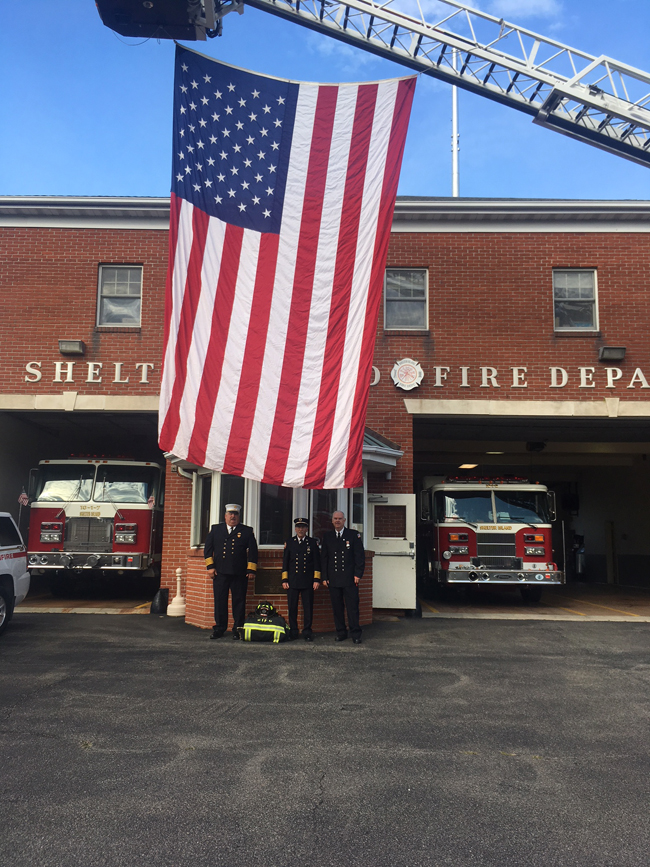Keeping happy times from turning tragic: How to prevent fires at home

Summer is the season best suited to memories, and pursuing once again the pleasures of summers past. A lot of those memories have to do with gathering with family and friends and cooking together and eating. The outdoor treats of grilling, sitting around a fire pit with hotdogs on a spear, or marshmallows turning just right over the flames to convert into s’mores.
Happy times, that sometimes turn into misery. And more than sometimes. According to the National Fire Protection Association (NFPA), fire departments are called to an annual average of more than 10,000 home emergencies every year involving grills, hibachis or barbecues. The NFPA’s Research, Data & Analytics Division reported that these blazes annually kill up to 10 Americans every year, cause 160 injuries and result in $123 million in property damages.
As every fire department, including Shelter Island’s, tell the people they protect, all of this grief can be avoided. Recently, Dr. Steven Sandoval, M.D., associate professor of surgery and medical director of the Suffolk County Volunteer Firefighters Burn Center at Stony Brook University Hospital, said staying safe this summer “is to prevent the burn in the first place with safety tips and precautions to eliminate potential dangers.”
The Burn Center has provided some precautions to protect yourself and loved ones from fires and exposure to too much sun that include:
• Limit the use of flammable liquids to start your fire pits and barbecues. Use only approved lighter fluids that are meant for cooking purposes. No gasoline or kerosene.
• Don’t leave hot coals from fire pits and barbecues lying on the ground for people to step on.
• When cleaning grills, the use of wire bristle brushes can result in ingestion of sharp bristle pieces requiring surgery.
• If you are overly tired, and consumed alcohol, do not use the stovetop, fire pit or a fireplace.
• Stay protected from the sun. Use hats and sunblock, and realize that sunblock needs to be reapplied after swimming or after sweating.
• Use the back burners of the stove to prevent children from reaching up and touching hot pots and pans.
• Always use oven mitts or potholders to remove hot items from the stove or microwave. Assume pots, pans and dishware are hot.
“If burned, do not go anywhere but a facility that specializes in burn treatment,” Dr. Sandoval said.
Shelter Island Fire Marshall Mike Johnson also is diligent in getting the word out to prevent home fires. Most home fires start in the kitchen, Marshall Johnson has said, because some people leave food cooking and unattended on top of the stove. Seniors and children seem to be the most vulnerable because of their robes and loose clothing getting near a flame or electric cooking top.
Stop. Drop. Roll. These are the three words to remember if one happens to catch fire. It is critical to remove the oxygen which is keeping the fire alive. Smothering the fire will put it out, he added. When one rolls on the floor or ground, the flames are getting smothered. The same thing happens when grease in a pan catches fire. Do not throw water on it. Put a lid over it to keep out oxygen and smother it.
Another kitchen hazard that can cause serious burns is boiling water. “It has the ability to scald the skin and can lead to infection,” the firefighter said.
He spoke about the need for smoke alarms and the need to change batteries twice a year.
“This makes sure that they are at their peak,” the marshall said, adding that even the hard-wired ones need battery backup.
Carbon monoxide detectors are extremely important since carbon monoxide removes oxygen from the body and makes one go to sleep. And it’s a sleep that goes on forever. It can happen fast.
Carbon monoxide comes from combustion. Don’t make a fire inside unless it’s in a fireplace or wood stove. Fires must be vented. That’s why people have succumbed when they mistakenly use charcoal grills in the house or use an electric generator indoors.
Marshall Johnson said to remember the three “P”s. Prevention. Planning. Practice.
According to Stony Brook University Hospital, it has the only designated burn care facility for more than 1.5 million residents of Suffolk County. The Burn Center at SBUH coordinates burn services throughout the county, and conducts training and research in burn care. The Burn Center also serves as a resource to neighboring community-based hospitals. Patients of all ages — from infants through seniors — are treated at the Burn Center.
To reach the Burn Center, call 631-444-4545. For immediate help, call the burn unit directly at 631-444-BURN.

